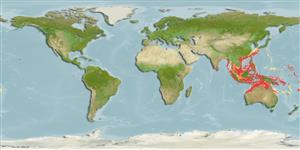Common names from other countries
分類 / Names
共通名の | 類義語 | Catalog of Fishes(部類, 種) | ITIS | CoL | WoRMS | Cloffa
>
Eupercaria/misc (Various families in series Eupercaria) >
Priacanthidae (Bigeyes or catalufas)
Etymology: Priacanthus: Greek, prion = saw + Greek, akantha = thorn (Ref. 45335).
More on author: Cuvier.
Environment: milieu / climate zone / depth range / distribution range
生態学
海 関連する礁; 海洋回遊性 (Ref. 51243); 深さの範囲 12 - 400 m (Ref. 90102). Subtropical; 32°N - 22°S
Western Pacific: southern Japan to western Indonesia, the Arafura Sea (Ref. 9819), and Australia. Reported from Peter the Great Bay (Ref. 27683).
サイズ / 重さ / 年齢
Maturity: Lm ? range ? - ? cm
Max length : 30.0 cm SL オス/雌雄の選別がない; (Ref. 48635)
背面の脊椎 (合計): 10; 背鰭 (合計): 12-14; 肛門の骨 3; 臀鰭: 13 - 14. Medium-sized fish of moderately deep body. The eyes large; the mouth oblique, with the lower jaw projecting upwards. The body tapers very slightly to beneath the middle of the soft portion of the dorsal fin, and then abruptly to the peduncle. This species is distinguished from P. fitchi by the presence of numerous rusty brown to yellowish spots in the membranes of the dorsal and anal fins, and its less tapered body.
Occurs in inshore and offshore reefs from less than 20 m to more than 400 m depths. Apparently forms aggregations in open bottom areas and is very abundant in the South China Sea and Andaman Sea. Marketed fresh, whole. Sound production has been studied in this species. Also found under ledges or hovering next to coral heads during day (Ref 90102).
Life cycle and mating behavior
成熟 | 繁殖 | 放精 | 卵 | 生産力 | 幼生
Starnes, W.C., 1988. Revision, phylogeny and biogeographic comments on the circumtropical marine percoid fish family Priacanthidae. Bull. Mar. Sci. 43(2):117-203. (Ref. 5403)
CITES (Ref. 128078)
Not Evaluated
Human uses
水産業: 商業
より多くの情報
参考文献水産養殖水産養殖の紹介緊張遺伝子のElectrophoreses遺伝病気行列Mass conversion
協力者画像Stamps, Coins Misc.音シガテラ(食中毒の名前)速度泳ぐ 型式カマOtoliths脳視覚
用具
特記事項
XMLをダウンロードして下さい
インターネットの情報源
Estimates based on models
Preferred temperature (Ref.
115969): 16.9 - 28, mean 24.4 (based on 682 cells).
Phylogenetic diversity index (Ref.
82804): PD
50 = 0.5002 [Uniqueness, from 0.5 = low to 2.0 = high].
Bayesian length-weight: a=0.01622 (0.01239 - 0.02122), b=2.91 (2.84 - 2.98), in cm Total Length, based on LWR estimates for this species (Ref.
93245).
栄養段階 (Ref.
69278): 4.1 ±0.60 se; based on food items.
回復力 (Ref.
120179): 手段, 1.4年~4.4年の倍増期間の最小個体群 (K=0.7-1.0; tmax=6).
Prior r = 0.32, 95% CL = 0.21 - 0.48, Based on 1 stock assessment.
Fishing Vulnerability (Ref.
59153): Low vulnerability (18 of 100).
Climate Vulnerability (Ref.
125649): High vulnerability (63 of 100).
